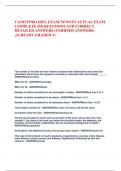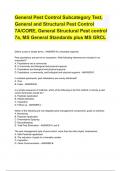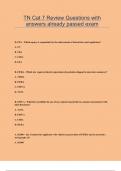CANFITPRO HWL EXAM NEWEST ACTUAL EXAM
COMPLETE 450 QUESTIONS AND CORRECT
DETAILED ANSWERS (VERIFIED ANSWERS)
|ALREADY GRADED A+
The number of fat cells we have remains constant after adolescence and cannot be
eliminated. We do have the capacity to increase or decrease their size through _____. -
ANSWERcaloric intake
BMI over 25 - ANSWEROverweight
BMI over 30 - ANSWERObesity
Number of adults considered to be overweight or obese - ANSWERMore than 2 in 3
Number of adults considered to be obese - ANSWERMore than 1 in 3
Number of adults considered to be extremely obese - ANSWERMore than 1 in 20
Total weight consists of - ANSWERWater mass, fat mass, and fat-free mass
fat located under the skin - ANSWERSubcutaneous fat
Fat that accumulates in areas such as the back of the arms, above each hip ("love
handles"), the sides of the back just below the shoulder blades, the abdomen, the
buttocks, and the thighs. Undesirable, but not necessarily dangerous to health. -
ANSWERSubcutaneous
fat located in the abdominal cavity and around major organs - ANSWERVisceral fat
This type of fat is linked to insulin resistance, hypertension, coronary artery disease,
heart disease, certain cancers and diabetes. Significantly influenced by diet and
exercise. - ANSWERVisceral
,condition in which fatty deposits called plaque build up on the inner walls of the arteries
- ANSWERAtherosclerosis
A person who appears skinny on the outside but is equally at risk as their heavier
counterparts. Risk of death may be higher for these individuals. 1 in 4 slim looking
people has pre-diabetes. - ANSWERMetabolically Obese Normal Weight (MONW)
Cause of serious risk for insulin resistance - ANSWERAbdominal fat
the study of food in all forms and how our bodies ingest, digest, metabolize, mobilize,
store, and excrete it. - ANSWERNutrition
Benefits of good nutrition - ANSWERpotential resistance to some disease, weight
management, increase physiological vibrancy and psychological health
The 6 essential nutrients - ANSWERcarbohydrates, proteins, fats, vitamins, minerals,
water
Macronutrients - ANSWERWater, protein, carbohydrates, fat
Micronutrients - ANSWERvitamins and minerals
3 concepts required for healthy nutrition - ANSWERquality, balance, portion control
knowledge of the anatomy of the digestive system provides - ANSWER1. an
understanding of the structure of the digestive system
2. an understanding of how food is digested
3. an understanding of how food and toxins can stress the digestive system
The 2 components of the digestive system - ANSWERThe digestive tract and the
accessory organs
an open system through which food passes to be broken down, used, or excreted -
ANSWERdigestive tract
____ connect to the digestive tract and provide some of the critical elements that allow
for the breakdown of food for absorption and/or excretion - ANSWERaccessory organs of
digestion
Anatomy of Digestive Tract - ANSWERmouth, esophagus, stomach, small intestine, large
intestine, rectum, anus
Where food enters and digestions begins mechanically through chewing and chemically
with saliva; mainly carbohydrate - ANSWERMouth
Links the mouth to the stomach - ANSWEREsophagus
where food is both mechanically and chemically broken down; primarily protein -
ANSWERstomach
,where food is both mechanically and chemically broken down and then absorbed into the
bloodstream - ANSWERsmall intestine
where bacteria continue to breakdown whatever is left of the food and where water is
extracted, forming feces - ANSWERlarge intestine
where feces are stored - ANSWERRectum
where waste exits the body - ANSWERanus
Anatomy of Accessory Digestive Organs - ANSWERsalivary glands, liver, gallbladder,
pancreas
glands in the mouth that secrete saliva, which contains enzymes that begin the
breakdown of carbohydrates - ANSWERsalivary glands
The ____ produces bile, used in the breakdown of fat, which is stored in the gallbladder.
It also serves as the major detoxification organ of the body, where the nutrient rich blood
is sent for detoxification prior to use in the body. - ANSWERliver
A muscular sac attached to the liver that secretes bile and stores it until needed for
digestion - ANSWERGallbladder
pancreas - ANSWERSecretes three groups of fluid:
1. fluids which buffer the acid from the stomach
2. hormones, including insulin and glucagon, which maintains blood sugar levels
3. enzymes which continue to breakdown carbs, fat and protein in the small intestine
most important nutrient; made of oxygen and hydrogen - ANSWERwater
Water accounts for what percentage of the body weight in a normal adult? -
ANSWER60%
functions of water - ANSWERhydration, transportation, temperature regulation,
lubrication, solvent
amount of water needed each day per kg of body weight - ANSWER30ml
a state in which the body has lost more water than has been taken in -
ANSWERDehydration
Symptoms of dehydration - ANSWERthirst, headache, fatigue, loss of appetite, dry eyes,
dry mouth, dark-colored urine with strong odour, flushed skin, heat intolerance, light-
headedness
Symptoms of severe dehydration - ANSWERdifficulty swallowing, clumsiness, shrivelled
skin, sunken eyes and dim vision, painful urination, numb skin, muscle spasms, delirium.
low sodium blood levels due to consuming too much water without electrolytes -
ANSWERHyponatremia
, symptoms of hyponatremia - ANSWER• nausea and vomiting
• headache
• confusion
• lethargy
• fatigue
• appetite loss
• restlessness and irritability
• muscle weakness
• spasms, or cramps
• seizures
• decreased consciousness or coma
Non-nutritious sources of water - ANSWERsoda, alcohol
Semi-nutritious sources of water - ANSWERtea, coffee, fresh squeezed juices in small
quantities (1-2 servings per day)
the second largest way to obtain the correct amount of water - ANSWERfood containing
water
the best way to consume the majority of daily water intake - ANSWERplain water
the building blocks; made up of 21 amino acids (9 essential and 12 non-essential) -
ANSWERproteins
essential amino acids - ANSWERhistidine, isoleucine, leucine, lysine, methionine,
phenylalanine, threonine, tryptophan, valine
non-essential amino acids - ANSWERalanine, arginine, asparagine, aspartic acid,
cysteine, glutamic acid, glutamine, glycine, proline, selenocysteine, serine, tyrosine
functions of proteins - ANSWER1. growth and repair of body tissues
2. formation of components necessary for bodily function (antibodies, enzymes, blood
proteins, hormones, sensory receptors)
3. Energy
used in immune system to fight infection - ANSWERAntibodies
_____ are used to control many chemical processes of the body including digestion and
energy metabolism - ANSWEREnzymes
blood proteins - ANSWER1. red blood cells contain hemoglobin that carries oxygen
throughout the body
2. lipoproteins transport fat and protein particles that move cholesterol throughout the
body
transport signals from one cell or gland to another part of the body - ANSWERhormones
used for sight, hearing and smell - ANSWERsensory receptors
grams of protein equal to 4 calories - ANSWER1g protein






